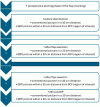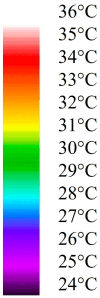Perfusion in Pedicled Skin Flaps: Initial Insights from Smartphone-Based Thermal Imaging Protocol
- PMID: 39063984
- PMCID: PMC11278002
- DOI: 10.3390/jpm14070730
Perfusion in Pedicled Skin Flaps: Initial Insights from Smartphone-Based Thermal Imaging Protocol
Abstract
Objective: Successful outcomes in head and neck surgery rely on maintaining perfusion in pedicled skin flaps. Thermal imaging offers a noninvasive means to assess tissue perfusion, potentially aiding in predicting flap viability. This pilot study explores the utility of SBTI (smartphone-based thermal imaging) for predicting flap vitality and monitoring during surgery.
Methods: Thermal imaging was employed using the FLIR One System. An imaging protocol was established, defining points of interest (T1-T4) on pedicled skin flaps. Conducted over four months, the study integrated SBTI into reconstructive surgery for the face, head and neck defects post-tumor resections. SBTI's effectiveness was assessed with n = 11 pedicled flaps, capturing images at key stages and correlating them with clinical flap assessment. Thermal images were retrospectively graded by two surgeons, evaluating flap perfusion on a scale from 1 to 5, based on temperature differences (1 = ΔT < 2 °C, 2 = ΔT ≥ 2 °C, 3 = ΔT ≥ 4 °C, 4 = ΔT ≥ 6 °C, and 5 = ΔT ≥ 8 °C), with assessments averaged for consensus and compared with the clinical assessment control group.
Results: The study encountered challenges during implementation, leading to the exclusion of six patients. Patient data included 11 cases with n = 44 SBTI images. Intraoperative assessments consistently showed good perfusion. One postoperative dehiscence was noted, which retrospectively coincided with intraoperative SBTI grading, but not with clinical assessment. Statistical analysis indicated consistent outcomes following clinical and SBTI assessments. Thermal imaging accurately predicted flap viability, although it had limitations with small flaps.
Conclusion: SBTI proved effective, inexpensive, and noninvasive for assessing tissue perfusion, showing promise for predicting flap viability and intraoperative monitoring in head and neck surgery.
Keywords: pedicled flaps; perfusion; skin flaps; smartphone diagnostics; thermal imaging.
Conflict of interest statement
Lukas S. Fiedler, Lukas Adrian, Burkard M. Lippert and Tobias Meyer declared that they have no conflicts of interest related to this manuscript. No financial or personal relationships with other people or organizations could potentially influence their objectivity in conducting or reporting the research described in the manuscript. All potential sources of conflicts of interest have been disclosed by the journal’s guidelines. The authors declare any potential conflicts of interest related to this research. This encompasses financial interests, such as patent or stock ownership, board memberships, advisory roles, and consultancy or speaker fees from companies.
Figures





Similar articles
-
Smartphone-based thermal imaging for pedicled skin flaps: a pilot study toward objective perfusion assessment in facial, head, and neck reconstruction.Eur Arch Otorhinolaryngol. 2025 Apr;282(4):2077-2085. doi: 10.1007/s00405-024-09048-3. Epub 2024 Oct 23. Eur Arch Otorhinolaryngol. 2025. PMID: 39443388
-
The Utility of Smartphone-Based Thermal Imaging in the Management and Monitoring of Microvascular Flap Procedures: A Systematic Review and Meta-Analysis.Ann Plast Surg. 2023 Jun 1;90(6S Suppl 4):S420-S425. doi: 10.1097/SAP.0000000000003343. Epub 2023 Feb 18. Ann Plast Surg. 2023. PMID: 37332214
-
Lower extremity reconstruction: utility of smartphone thermal imaging camera in planning perforator based pedicled flaps.J Ayub Med Coll Abbottabad. 2020 Oct-Dec;32(Suppl 1)(4):S612-S617. J Ayub Med Coll Abbottabad. 2020. PMID: 33754517
-
Intraoperative laser-assisted indocyanine green imaging for objective measurement of the vascular delay technique in locoregional head and neck flaps.JAMA Facial Plast Surg. 2014 Sep-Oct;16(5):343-7. doi: 10.1001/jamafacial.2014.106. JAMA Facial Plast Surg. 2014. PMID: 24903124
-
Indocyanine green angiography for preventing postoperative mastectomy skin flap necrosis in immediate breast reconstruction.Cochrane Database Syst Rev. 2020 Apr 22;4(4):CD013280. doi: 10.1002/14651858.CD013280.pub2. Cochrane Database Syst Rev. 2020. PMID: 32320056 Free PMC article.
Cited by
-
Flap Monitoring Techniques: A Review.J Clin Med. 2024 Sep 14;13(18):5467. doi: 10.3390/jcm13185467. J Clin Med. 2024. PMID: 39336953 Free PMC article. Review.
-
Advancing DIEP Flap Monitoring with Optical Imaging Techniques: A Narrative Review.Sensors (Basel). 2024 Jul 10;24(14):4457. doi: 10.3390/s24144457. Sensors (Basel). 2024. PMID: 39065854 Free PMC article. Review.
References
-
- Nischwitz S.P., Luze H., Schellnegger M., Gatterer S.J., Tuca A.C., Winter R., Kamolz L.P. Thermal, Hyperspectral, and Laser Doppler Imaging: Non-Invasive Tools for Detection of The Deep Inferior Epigastric Artery Perforators—A Prospective Comparison Study. J. Pers. Med. 2021;11:1005. doi: 10.3390/jpm11101005. - DOI - PMC - PubMed
-
- Veldhuizen I.J., Brouwer P., Aleisa A., Kurtansky N.R., Dusza S.W., Nehal K.S., Hoogbergen M.M., van der Hulst R., Lee E.H. Nasal skin reconstruction: Time to rethink the reconstructive ladder? J. Plast. Reconstr. Aesthet. Surg. 2022;75:1239–1245. doi: 10.1016/j.bjps.2021.11.028. - DOI - PMC - PubMed
-
- Larrabee W.F. Jr., Sherris D.A., Teixeira J., editors. Principles of Facial Reconstruction: A Subunit Approach to Cutaneous Repair. Thieme Medical Publishers, Inc.; New York, NY, USA: 2021. Soft Tissue Biomechanics and Physiology.
-
- Whitaker I.S., Rozen W.M., Chubb D., Acosta R., Kiil B.J., Birke-Sorensen H., Grinsell D., Ashton M.W. Postoperative monitoring of free flaps in autologous breast reconstruction: A multicenter comparison of 398 flaps using clinical monitoring, microdialysis, and the implantable Doppler probe. J. Reconstr. Microsurg. 2010;26:409–416. doi: 10.1055/s-0030-1249607. - DOI - PubMed
LinkOut - more resources
Full Text Sources

